Tuesday, September 29
A roundtable discussion on the theme of "A New Choice: Wind People Unbound by the Times" was held in Aoyama. It was a commemorative event for the publication of the book, "A New Choice of 'Wind People' to Change the Region," and was organized by the seminar students of Professor Hiroyuki Fujishiro of Faculty of Social Sciences. Local journalist Terumi Tanaka and I were the guests. The "people of the soil" are those who were born and raised in the local community, while the "people of the wind" are those who come from the outside and change the community. I was asked the question, "There were people of the wind in the Edo period, weren't there?" I am the one who receives the question, "What do you mean? In other words, I am not appearing as President, but as an Edo researcher. Indeed, so many occupations were moving and drifting in the Edo period, and the drifters changed the culture of the settled people. And, having grown up in the countryside, OGISOvilification, who grew up in the countryside, sharply pointed out what was wrong with the samurai in Edo and the provincial cities. People of the wind," is a wonderful phrase.
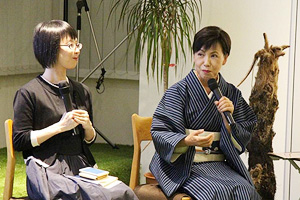
Wednesday, September 23
There was a recording of the BS-TBS TV program "Osamu Hayashi: The World's Greatest Books". I was asked to write a book titled "Ichiyo Higuchi: No, I hate it! I am publishing a book on Ichiyo Higuchi titled "Ichiyo Higuchi: No! So I chose "Takekurabe". I talked about the brilliant "sōmon-ka" structure of this work. The more I read it, the more I realize how amazing it is that a 23-year-old genius has created modern literature by mobilizing all the traditional methods of Japanese literature. I am again astonished by the role of women in the creation of Japanese culture.
We attended the "Osamu Kitayama's Academic Theater" series by Dr. Osamu Kitayama (psychoanalyst and psychiatrist), who is Vice President Hakuo University. The Shibuya Public Hall was filled to capacity. Rakugo storyteller Katsura Bunshi performed with him. The theme was rakugo analysis, and the song "Children Who Don't Know War," written by Osamu Kitayama in 1970, was sung. The audience was reminded of the efforts that Japan has accumulated over the past 70 years and the fact that the oldest children who have grown up in these efforts and who do not know war are now 70 years old. Imujing River" was a song about the Korean War and the division of the peninsula, which at the time could only be heard at concerts due to the voluntary suspension of broadcasts by various stations. Children who have never known war have always been aware of it and worried about it. Why is the end of it today's Japan?
September 21 (Monday)
We visited Ms. Peng Tan, author of "China, Tea Bowl, and Japan" (Shogakukan), at Kenchoji Temple in Kamakura. Peng Tan is a graduate of the Institute of International Japanese Studies TUFS with a doctorate degree, and has recently been granted permanent residence in Japan in recognition of his achievements in Japanese cultural studies. The purpose of my visit was to congratulate him and to extend my best wishes to the Kenchoji Temple and the President Kenchoji Temple for his continued support of Pengtan. I am currently teaching a literature course in Faculty of Social Sciences. She writes very beautiful Japanese. She also lectures at Kencho-ji Temple on the words of its founder, Rankei Doryu, and last year, through her efforts, she was able to locate the place where Rankei Doryu was born for the first time.
September 19 (Saturday)
It was a degree conferment ceremony for September graduates. Unlike in March, even if it is now only an issue for the Self-Defense Forces, the participation of Japanese nationals, including Self-Defense Force personnel, in the war has become a real issue. How do universities face this reality? How will the university face this reality? As a citizen, I must continue to think about this issue, and at the same time, I must continue to think about my position as " President " a position that has a history of sending students to the battlefield together with the government. We need to have a comprehensive vision for the future of society and the university, not just an opposition to it.
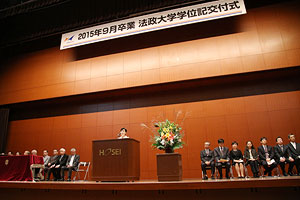
There was a celebration for those who passed the bar exam of the law school. This year, we had many successful candidates and the atmosphere was bright and lively. However, we must continue to consider what a law school is and what kind of system is truly desirable as a broader issue.
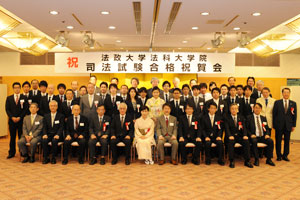
September 17 (Thursday)
I attended the "Samisamai," an event of the Editorial Engineering Research at Gotokuji Temple. Produced by Seigo Matsuoka, Hidetaro Honjo and his company come to this event about once every three months. Hidetaro Honjo is not only a performer of shamisen, nagauta, kouta, and hachauta, but also a researcher of local folk songs and hachauta, and a composer and arranger of a completely new type of Japanese music. On this occasion, he also performed a new song written by Seigo Matsuoka. Seigo Matsuoka is also the composer and lyricist of "Hiei oroshi," a song that people of my generation have heard at least once.
Kimono coordinator Yoshihiko Egi always coordinates and dresses Matsuoka-san and Honjo-san for this event. Ever since I experienced Yoshihiko Egi's kimono dressing on my job at Shiseido, I have considered him the best kimono stylist in Japan.
It is in places like this that new creations of Japanese culture are being made in a deep, quiet, and modest way.
Also, as I mentioned on July 7, I have long been paying attention to the Internet class method of the "Isis Editing School," an editing engineering research institute. This is because it has a method for students to acquire the basics of thinking, judgment, and expression on their own. It is an online school that individuals enter, but some universities have introduced it on the premise of credit accreditation.
September 14 (Monday)
Today is the day of the Fall Admission Ceremony for GIS (the Faculty of Global and Interdisciplinary Studies Global Studies), which was held in a small, intimate setting.
On the April Commencement Day, I spoke about Malala Yousufzai. Today, as a continuation of that story, I talked about how in July the Malala Foundation created a girls' school for Syrian refugees in eastern Lebanon. As new students know that more than 300,000 Syrian refugees have already entered Europe, I mentioned that 10 times more people than that are living as refugees in the countries surrounding Syria, and I told them that schools are created because citizens of that era need them, and that Hosei University We asked the students to imagine what it was like at the time of its establishment.
From next year, the entrance ceremony will be held in conjunction with several graduate schools. Gradually, the number of students enrolling in the fall will increase. The farewell address will be given twice a year. Will it be possible to make it a "sequel"?
The Mainichi Newspaper interviewed us. The reporter, who learned about the content of my confession at the degree conferment ceremony held in March, came to ask about the situation in Japan in the background of the postwar environmental problems.
I was told that there was a meeting of the British Alumni Association, so I sent a video message to them. I was in Oxford for a year, so it was very nostalgic. I would be happy to have another opportunity to visit the U.K., but as the President first duty is to protect the university, there will be no personal travel while I am in office.
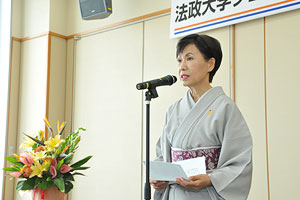
September 12 (Saturday)
The "Bee in the Sky," which I wrote about in the June 4 President Journal, has been released nationwide. The director of this film, Yukihiko Tsutsumi, is a graduate of Department of SociologyFaculty of Social Sciences of the University of Tokyo and is currently studying geography in the School of Correspondence Education. The theme song was composed and sung by Motohiro Hata, a graduate of Hosei II High School and the Department of Business Administration.
This film reminds us of 3.11. The nuclear reactors have been restarted, but please think about whether or not this is the right thing to do. If the security bill is enacted, there are fears of terrorism against Japan and Japanese people (like the case of Kenji Goto). This film will give you an opportunity to think about that as well.
The Japan Society of Medical Social Welfare held a conference at Japan Women's University, where I delivered a keynote lecture on "Looking at Life and Curing from the Perspective of Edo: Life and Curing. I also discussed "Yosei-kun" by Kaibara Masuken, in which he says something like this: "Without yosei, there is no medicine and no needles. In the book, there is a passage in which Kaibara Mashuken says, "Attacking and trying to cure illnesses with medicines and acupuncture without curing them is like using military power instead of virtue to govern a country. Fighting a hundred times and winning a hundred times is meaningless" (modern translation). Virtue is the ability to realize ethical ideals and the power to act, express, and inspire.
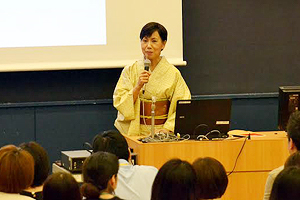
September 11 (Friday)
In Shizuoka, I gave a lecture sponsored by the Shizuoka Nikkei Konwakai. I spoke on "Globalization and the Edo Period. Japan should be able to "uniquely respond" to globalization in various ways, not by following or becoming a pawn of a major power.
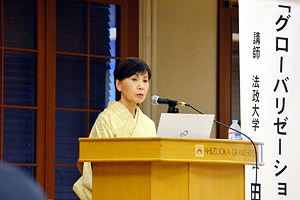
September 10 (Thursday)
Ms. Misako Rocks visited the President Office on her way back to New York. She is a like-minded person who will do whatever it takes for Hosei! She is a person who shares the same aspiration as I do. Mr. Takashi Ikushima, the manager of the Japan side, is also doing a lot of work for the university. I hope that he will continue to tell many people what studying abroad is, what you can see there, and that there are already opportunities all over the world to play an active role.
September 7 (Monday)
The President Cup and All-Hosei Golf Tournament sponsored by the Alumni Association was held at the Kingfields Golf Club in Chiba Prefecture. Last year, I had to give a lecture in a rural area and could not go to hand out the President Cup, but this year, I successfully handed the cup to the winner.
Even though heavy rain, thunder, and gusty winds were forecast for Chiba Prefecture that day, it only rained a little in the morning on the golf course, but not at all the rest of the day, and the sun even came out at times. Then, just as everyone finished playing and the indoor cup-passing reception was about to begin, it began to rain. It was like a miracle.
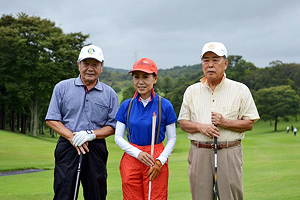
I would like to thank Mr. Hidemitsu Kuwano, President of the Alumni Association, and Mr. Yasuhiro Suzuki, President of Kingfields Golf Club, and their employees for managing the more than 180 participants so smoothly and allowing everyone to enjoy the day without any accidents.
Thank you to the alumni who came from all walks of life to share a place to not only "watch" but also "play" sports and communicate with each other in a healthy way. Let's continue to exchange opinions more openly about various issues and ways of being at the university under this open atmosphere.
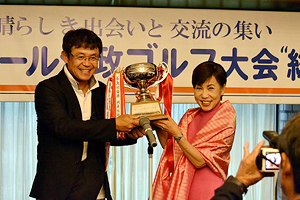
September 5 (Saturday)
I am a little tired from all the standing around. I wish I could take a day off, but today is the 90th anniversary celebration of the cheerleading squad. I can't take a day off. The ceremony was held in the afternoon and a big party was held in the evening with about 800 people.
The cheerleading squad has not only contributed to the establishment of the school song, but has also created many other cheer songs since then. In particular, the cheerleaders of Hosei University were the pioneers of cheerleading in Japan.
Naoko Asai, a Hosei University student, became the first Japanese to study American cheerleading while still in school, won the grand trophy, and became a pioneer of cheerleading. The cheerleading squad is composed of a leader club, a cheerleading club, and a brass band, and has created a unique cheerleading style for 90 years.
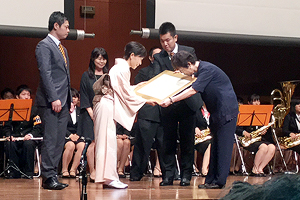
We have also been to Germany and Switzerland. It seems that people overseas consider it a "Japanese tradition. Certainly, the combination of school run, action, sound, and rhythm are all modern, so it is by no means a classic, but it has become a tradition. Moreover, the style is so clear that it can be caricatured in a comic strip. It was originally born to relativize the elite air of barbarism (the antagonist of high culture), but now that it has lost that function, why hasn't the style remained the same? That is the kind of curiosity that got me thinking.
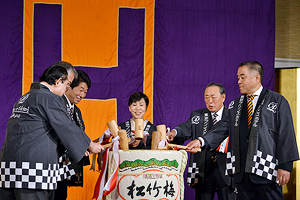
Thursday, September 3 and Friday, September 4
I wrote last month that I was busy preparing for the JMOOC during the summer, but that was because I had to stay in the studio for the past three or four days to finish recording 24 lectures. To do this, I had to prepare about 70,000 words of script and about 220 illustrations, including text. Many of the illustrations required permission to be used, and the university's educational support office was quick to apply for permission.
Although JMOOC does not charge students for the course, permission is still required to broadcast the course on the Internet.
I am grateful to all those involved in the production of the JMOOC.

